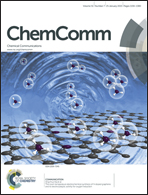Self-catalysis by aminosilanes and strong surface oxidation by O2 plasma in plasma-enhanced atomic layer deposition of high-quality SiO2†
Abstract
Plasma-enhanced atomic layer deposition (PE-ALD) has been applied to prepare high-quality ultrathin films for microelectronics, catalysis, and energy applications. The possible pathways for SiO2 PE-ALD using aminosilanes and O2 plasma have been investigated by density functional theory calculations. The silane half-reaction between SiH4 and surface –OH is very difficult and requires a high activation free energy of 57.8 kcal mol−1. The introduction of an aminosilane, such as BDMAS, can reduce the activation free energy to 11.0 kcal mol−1 and the aminosilane plays the role of a self-catalyst in Si–O formation through the relevant half-reaction. Among the various species generated in O2 plasma, 3O2 is inactive towards surface silane groups, similar to ordinary oxygen gas. The other three species, 1O2, 1O, and 3O, can strongly oxidize surface silane groups through one-step or stepwise pathways. In the 3O pathway, the triplet must be converted into the singlet and follow the 1O pathway. Meanwhile, both 1O and 3O can decay to 1O2 and enter into the relevant oxidation pathway. The concept of self-catalysis of aminosilanes may be invoked to design and prepare more effective Si precursors for SiO2 ALD. At the same time, the mechanism of strong surface oxidation by O2 plasma may be exploited in the PE-ALD preparation of other oxides, such as Al2O3, HfO2, ZrO2, and TiO2.


 Please wait while we load your content...
Please wait while we load your content...